Related Categories: Alternative Interfaces | Art Installations
Summary:
Moving Canvas, a combination of technologies and installations designed by Frédéric Eyl, Gunnar Green, and Richard The, involves the placement of an LED projection device (“Parasite”) on the side of a commuter subway train. The device is enclosed in a suitcase equipped with suction cups, and its projection aligned with the subway walls. The ensuing display projects words and images on the tunnel walls, viewable through the train windows. Cinematic time and commuter time combine radically as bodies and messages literally communicate through the subway tunnels.
The project was developed in 2005 as part of a digital media class at the Berlin University of the Arts, and exhibited with the university’s “Here/There” project. Moving Canvas takes another look at the problem of here and there by asking what lies between.
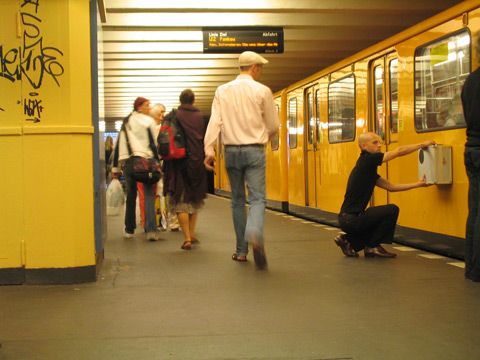
Image of the placement of Parasite on the side of a Berlin subway train.
Description:
The artists refer to Moving Canvas as a collection of several proposals, each of which takes on an aspect of the communication potential of commuter space. Moving Canvas is a combination of “Parasite,” a mobile projection system designed to project images and words on to the walls of a subway from a position on the side of a moving train, and “Parallel Worlds,” the description of the experience of viewing these projections from the inside of the train.
Marc Augé says that “to speak of the metro first of all means to speak of reading and of cartography” (In the Metro), and the work of Eyl, Green and The literalizes this by transforming the subway walls into a reading interface. The work plays with the strangeness of thinking about reading in relation to the physical infrastructure of commuter rail networks, and this strangeness is instructive for how Moving Canvas conceptualizes the conversations between the communication processes of new media and spatial communication systems including architecture, transit systems and text.
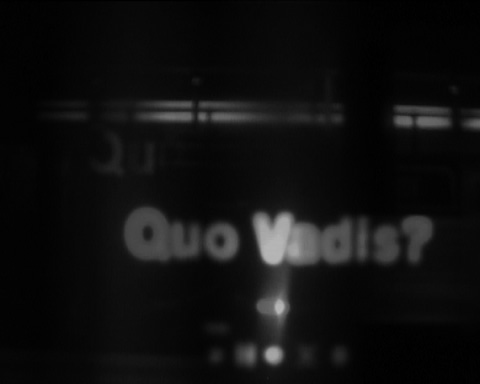
Image of writing projected on the subway walls taken from moving train.
According to Eyl, Green The, the proposals of Moving Canvas “all have emerged from our reflection on the visual and symbolical importance of trains in an urban context and the possibility of exploiting their short-lived prominence as brief communicative moments.” The artists reconfigure tunnel walls, often anonymous and seen only from the perspective of a moving train, as dynamic and interpretive public space available for reading and writing upon.
One concern of this project is the commodification of projection systems, which may make a project like Moving Canvas more easily executed, but also signals its availability to commercial advertising. They aim to pre-empt the conquest of public space, and in particular the canvases of walls and tunnels, through their own deployment of an affordable projection device. Eyl, Green and The express discomfort with the writing systems currently available for this form of protest, and worry that the re-conquest of public space is “reduced to graffiti and street art.”
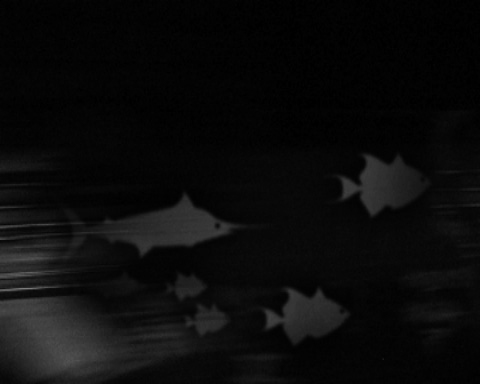
Image of projection on subway tunnel wall.
The artists also hope, through the experience of viewing the projections they refer to as Parallel Worlds, that the public audience will be productively disoriented. Eyl, Green and The intend the work to be a surprise to passengers, who in their account are likely never to have seen the subway tunnel walls by foot or from any other perspective. They describe the projected images as a “a glimpse into a different world full of surrealist imagery.”

Image of observer viewing projections.
Research Context:
Moving Canvas thinks through the multiple modalities of passability (what Heidegger refers to as “forming a way and making it ready) as processes that involve images, bodies, information and transportation in networks of communication.
Michel de Certeau offers a few suggestions for reconciling metro movement and reading, perhaps most famously when he calls attention to the name of the Athens subway system as the metaphorai. In The Practice of Everyday Life, de Certeau says of the subway, “Every being is placed there like a printer’s type on a page arranged in military order. This order, an organizational system, the quietude of a certain reason, is the condition of both a railway car’s and a text’s movement from one place to another.” The hyper-literalization, or overexplicitness of the relation of textual movement, car movement, and body movement in Moving Canvas pushes on this idea.
The structure of the subway itself as a communications system also calls attention to the potential — missed or captured — for collective experience. Augé’s work on the Paris Metro, referenced earlier, could also be thought of in relation to his ideas of “non-place” in contemporary architecture: “Against the backdrop of the metro our individual acrobatics thus seem to play a fortuitously calming effect in the destiny of everyone’s daily lives, in the law of human actions summed up by a few commonplaces and symbolized by a strange public place — an interlacing of routes whose several explicit prohibitions (‘no smoking,’ ‘no entry’) underscore its collective and ruled character” (In the Metro). The strange separateness and collectivity of subway travel is questioned by the collective reading of the subway walls in Moving Canvas.
Another potential trajectory for thinking about these issues would be Geoff Ryman’s novel 253 (http://www.ryman-novel.com), which turns the subway journey into the text. A comparison between Ryman’s text and the literalness of Moving Canvas puts the medium itself at the center of the debate. 253 announces on its opening page, “In cyberspace, people become places,” and Moving Canvas performs a hybrid of cyberspace and built space, testing the boundaries of the two.
It becomes important, in the reading of Moving Canvas, to consider the relationship of reading, architecture, infrastructure and communication, and what counts as a reading landscape. This work operates with a strange self-reflexivity in relation to space, reading, and motion, which could be partially understood through Brian Massumi’s deployment of “proprioception.” This sense, in his account, becomes heightened in the urban spaces of the metro: “The paucity of visual cues in tunnel-like places like corridors and subways requires a backup system to take over from the usual way of orienting” (Parables for the Virtual). The Moving Canvas installation participates in its own self-creation through a form of self-reflection, demanding a new orientation, or a new way to read space.
Finally, this project takes seriously the communication potential of bodies, trains, place and information together. Friedrich Kittler argues for a kind of reduction of what counts as ‘things communicated’ to an information model: “Ultimately, communication too depends on control signals, the more so the more complex its working; even the triad of ‘things communicated’ — information, persons, goods — can be reformulated in terms of information theory.” Perhaps for Moving Canvas, it’s time to recomplexify the idea of communication to include information, persons and goods as things that can be communicated.
Technical Analysis:
The projection system of Moving Canvas, Parasite, consists of a suitcase containing its basic components. Inside the suitcase is a Mac Mini hard drive, an LCD projector and a mirror to direct the projection image, and a battery to power both devices.
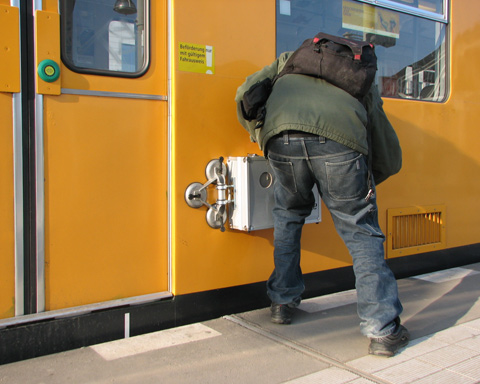
Image of the attachment of Parasite to a subway train.
The suitcase is attached to the side of the train with suction pads, and the projection begins when the train begins to move, using the speed of the train as a parameter for the content of the projection.
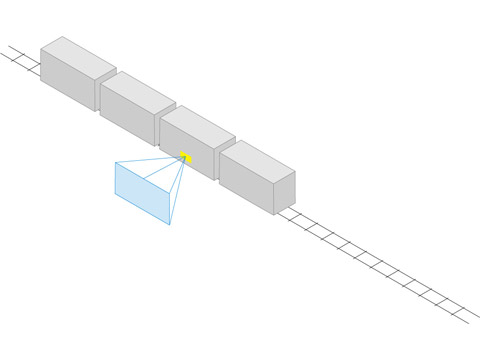
Image of Parasite model.
Evaluation of Opportunities/Limitations for the Transliteracies Topic:
The idea that metropolitan rail networks form dynamic communication interfaces has considerable potential for expanding the definition of the reading interface to include vast quantities of urban space. In addition, Moving Canvas’s demonstrated interest in the community experience of reading, and how various publics can be constituted spatially and through the shared practice of reading, makes it a valuable exploration of the expanded geographies of reading made possible by technological innovation.
The textual element of Moving Canvas does, however, appear somewhat limited and at times arbitrary, and the artists focus on the project’s underwater imagery and disconcerting surrealism. The “reading” of these projections is intended to be experienced phenomenologically but not necessarily interpreted.
Resources for Further Study:
- Moving Canvas
- Parasite
- Video
- Augé, Marc. In the Metro. Minneapolis: University of Minnesota Press, 2002.
- de Certeau, Michel. The Practice of Everyday Life. Translated by Steven Rendall. Berkeley: University of California Press, 1984.
- Kittler, Friedrich. “The History of Communication Media.”
- Massumi, Brian. Parables for the Virtual: Movement, Affect, Sensation. Durham: Duke University Press, 2002.
- Ryman, Geoff. 253.
